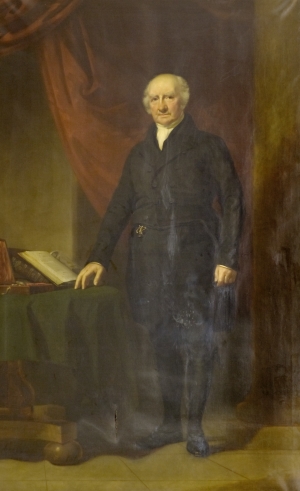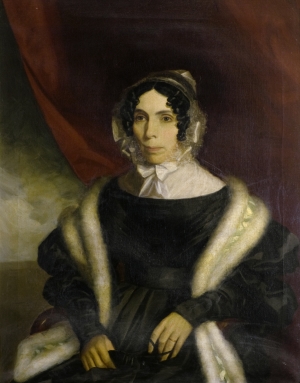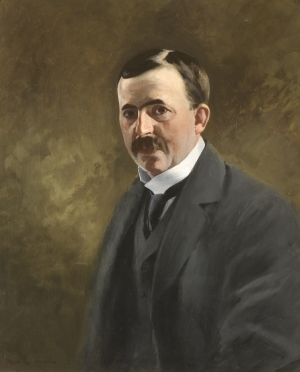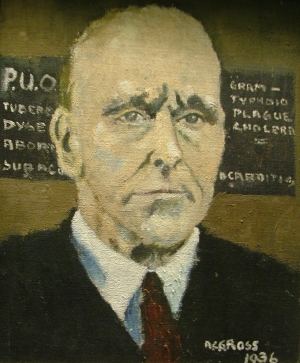Medical Portraits
The paintings and sculpture shown here are part of the Tayside Medical History Museum's collection and depict notable medical personalities from Dundee and Tayside. Many were originally displayed at Dundee Royal Infirmary and most are now on display at Ninewells Hospital.
 |
John Crichton, 1841 Oil on canvas John Gibson After a year at St Andrews studying Greek and Latin, Crichton (1772-1860) moved to Edinburgh and obtained the diploma of the College of Surgeons in 1790. After his medical and surgical studies, he returned to Dundee and set up a practice in the north side of the Overgate. When the first Dundee Infirmary was opened in 1798, Crichton was one of the original 3 surgeons and 2 physicians first appointed. He served as attending surgeon until 1855 and from then remained as a consulting surgeon until his death. DUNUC ARTS:2378 |
 |
Alexander Bell FRCS Oil on canvas John Stewart Bell (1771-1852) was a surgeon at Dundee Royal Infirmary from 1807 to 1837, in addition to operating his large practice in the town. Bell took an early interest in vaccination against smallpox, having witnessed the failure of innoculation during his training. In 1816 he was responsible for ordering "good surgical instruments" for the Infirmary. This portrait was painted by the Dundee artist John Stewart and remained with the Bell family until it was presented to DRI by his grandson, Lieutenant-Colonel Alexander Henry Bell, along with the matching portrait of his wife (see below).
DUNUC ARTS:2472 |
 |
Anne Ruthven Leven Bell Oil on canvas Attributed to Peter Paillou Jr (1757-1832) Wife of Alexander Bell DUNUC ARTS:2473 |
 |
James Arrott, 1877 Oil on canvas John Stewart Born in Arbroath, Arrott (1808-83) studied medicine at the University of St Andrews then became assistant to the infamous anatomist Dr Knox in Edinburgh. He studied for some time on the Continent before beginning practice as a physician in Dundee. He was a consulting physician at Dundee Royal Infirmary for many years, and this portrait was commissioned by public subscription and presented to him along with a purse of sovereigns. On long-term loan from Dundee Art Galleries & Museums DUNUC ARTS:2379 |
 |
Sir James Mackenzie MD FRS LLD Bronze bust on wooden stand Unknown artist Born at Pictstonhill near Scone, Mackenzie was a celebrated heart specialist. After studying in Edinburgh he set up practice for many years in Burnley, Lancashire. Mackenzie's particular interest was in diseases of the heart. Recognising the limitations of the sphygmograph to record the pulse, he pioneered a device which he called a polygraph. It allowed for the first time simultaneous recordings of the arterial and venous pulses. This revolutionised the diagnosis of heart problems and later became the basis for lie detectors. Mackenzie also discovered premature ventricular contractions and drew attention to the question of the heart's capacity for work, paving the way for the study of the energetics of the heart muscle. He also demonstrated the effectiveness of digitalis in the treatment of arrhythmias. In 1907 Mackenzie left Burley and became a successful consulting physician in London. In 1915 he was elected a Fellow of the Royal Society and was awarded a knighthood. In 1918 he founded the influential Mackenzie Institute of Clinical Research in St Andrews, which involved local GPs in detailed long-term recording of patients' symptoms and illnesses. DUNUC ARTS:2928 |
 |
Dr George Lawrence, 1913 Oil on canvas William Bradley Lamond (1857-1924) Lawrence (1871-1912) was a popular GP in Dundee. This portrait was presented to his father by "grateful patients and friends to mark their appreciation of valuable services to the community". A larger version was gifted to the city's permanent collection. DUNUC ARTS:69 |
 |
Professor W J Tulloch, 1936 Oil on canvas A C G Ross A native of Dundee and appointed to the Chair of Bacteriology in the Medical School 'ad vitam aut culpat' (for life or until fault), Tulloch stayed in this post for 42 years before retiring voluntarily aged 74. His unique teaching and examining relationship with the students helped to produce enthusiastic recruits for his speciality. He served as Dean of Medicine in 1945-56. DUNUC ARTS:2411 |
 |
Sir Ian Hill, 1969 Oil on canvas Alberto Morrocco (1917-1998) Ian George Wilson Hill (1905-82) was born in Shotts, Lanarkshire, and studied medicine at Edinburgh University, graduating with distinction in 1928. In 1932 a Rockefeller Travelling Scholarship enabled him to work in the USA at the ‘Heart Station’ in Michigan, alongside the pioneer of electrocardiography, Frank Wilson. Hill and Wilson’s joint publications in the 1930s laid the foundations for the analysis of ECG patterns in infarction (heart attacks). On returning to Scotland after the war, Hill introduced the unipolar lead system that he had helped Wilson develop, enabling a significant advancement of electrocardiography. Hill’s original leads still survive and are in the collection of the Tayside Medical History Museum. In 1950 Hill was appointed Professor of Medicine in Dundee and continued his interests in cardiology until his retiral in 1969. He was made President of the Royal College of Physicians of Edinburgh in 1963, and is shown here wearing his robes of office. He also served as Honorary Physician to the Queen in Scotland. DUNUC ARTS:92 |
Back to Tayside Medical History Museum Art Collection Index